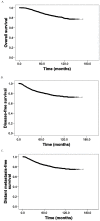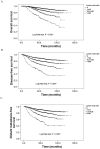Prognostic value of metastatic axillary lymph node ratio for Chinese breast cancer patients
- PMID: 23626682
- PMCID: PMC3634079
- DOI: 10.1371/journal.pone.0061410
Prognostic value of metastatic axillary lymph node ratio for Chinese breast cancer patients
Abstract
Objective: The prevalence of breast cancer varies among countries and regions. This retrospective study investigated the prognostic value of the lymph node ratio (LNR) compared with the number of positive lymph nodes (pN) in Chinese breast cancer patients.
Methods: The medical records of female breast cancer patients (N = 2591) were retrospectively evaluated. The association of LNR and TMN staging system were compared with respect to overall, disease-free, and distant metastasis-free survival.
Results: Out of 2591 patients, 2495 underwent modified radical surgery and 96 received breast conserving surgery. All patients had adjuvant chemotherapy following surgery. The median follow up period 66.9 months (range 5-168 months). The 5-year and 10-year overall survival rates were 89.3% and 78.8%, respectively, and 5-year disease-free survival and distant metastasis-free survival rates were 81.6% and 83.5%, respectively. Univariate analysis indicated that in general T, pN, LNR, as well as tumor expression of the estrogen receptor, progesterone receptor, and HER2 were associated with overall, disease-free, and distant metastasis-free survival (all P-values <0.05). Mutlivariate analysis found pN stage and LNR were independent predictors of overall, disease-free, and distant metastasis-free survival (all P-values <0.001). If pN stage and LNR were both included in a multivariate analysis, LNR was still an independent prognostic factor for overall, disease-free, and distant metastasis-free survival (all P-values <0.001).
Conclusion: Our findings support the use of LNR as a predictor of survival in Chinese patients with breast cancer, and that LNR is superior to pN stage in determining disease prognosis.
Conflict of interest statement
Figures
References
-
- Rosen PR, Groshen S, Saigo PE, Kinne DW, Hellman S (1989) A long-term follow-up study of survival in stage I (T1N0M0) and stage II (T1N1M0) breast carcinoma. J Clin Oncol 7: 355–366. - PubMed
-
- Vinh-Hung V, Cserni G, Burzykowski T, van de Steene J, Voordeckers M, et al. (2003) Effect of the number of uninvolved nodes on survival in early breast cancer. Oncol Rep 10: 363–368. - PubMed
-
- Vinh-Hung V, Burzykowski T, Cserni G, Voordeckers M, Van De Steene J, et al. (2003) Functional form of the effect of the numbers of axillary nodes on survival in early breast cancer. Int J Oncol 22: 697–704. - PubMed
-
- Carter CL, Allen C, Henson DE (1989) Relation of tumor size, lymph node status, and survival in 24,740 breast cancer cases. Cancer 63: 181–187. - PubMed
-
- Axelsson CK, Mouridsen HT, Zedeler K (1992) Axillary dissection of level I and II lymph nodes is important in breast cancer classification. The Danish Breast Cancer Cooperative Group (DBCG). Eur J Cancer 28A: 1415–1418. - PubMed
MeSH terms
Substances
LinkOut - more resources
Full Text Sources
Other Literature Sources
Medical
Research Materials
Miscellaneous



